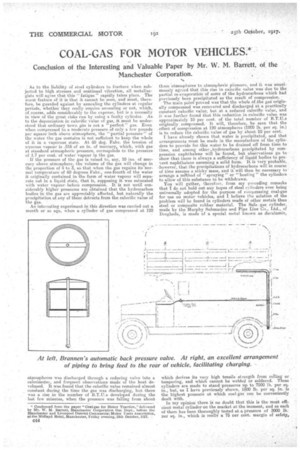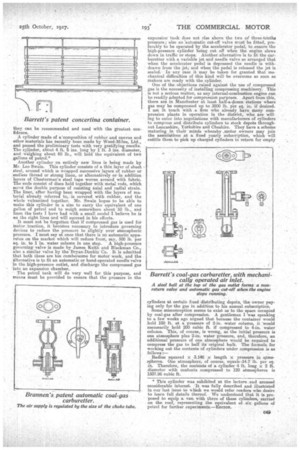COAL-GAS FOR MOTOR VEHICLES.*
Page 14

Page 15

If you've noticed an error in this article please click here to report it so we can fix it.
Conclusion of the Interesting and Valuable Paper by Mr. W. M. Barrett, of, the
Manchester Corporation.
As to the liability of steel cylinders to fracture when subjected to high stresses and continual vibration, all metallurgists will agree that this " fatigue" rapidly takes place. The worst feature Of it is that it cannot be seen, and must, therefore, be guarded against by annealing the cylinders at regular periods, whether they really. require annealing or not, which, of course, adds considerably to the expense, but is a necessity in view of the great risks run by using a faulty cylinder. As to the depreciation in calorific value of gas, it must be understood that ordinary town gas is not a " perfect " gas. Even when compressed to a moderate pressure of only a few pounds per square. inch above atmosphere; the "partial pleasure" of the water the gas contains is not sufficient to keep the wlio!e of it in a vaporouS state. At 60 deg. Fahr. the tension of aqueous vapoue is .518 of an in. of mercury, which, with gas at standard atmospheric pressure, correspOnds to the pressure of 1.7 per cent, of water vapour in the gas.
• If the pressure of the gas is raised to, say, 10 ins of mercury above atmosphere, the volume of the gas will change in the proportion of 4 to 3, so that when the gas regains its normal temperature of 60 degrees Fahr., one-fourth of the water it originally contained in the form of water vapour will separate out in a liquid state, that is, supposing it was saturated with water vapour.. before compression. It is not until considerably higher pressures are obtained that the hydrocarbon bodies in the gas are appreciably affected, but naturally the precipitation of any of these detracts from the calmific value of the gas.
An interesting experiment in this direction was carried out a month or so ago, when a cylinder of gas compressed at 120 atmospheres was discharged through a reducing valve into a calorimeter, and frequent observations made of the heat developed. It was found that the calorific value remained almost constant during the time the gas was discharging, but. there was a rise in the number of B.T.1T.s developed during the last few minutes, when the pressure was falling frnm about
* Condensed from the paper "Coal-gas for Motor Traction," delivered by Mr. W. M. Barrett, Manchester Corporation Gas Dept., before the Manchester and Liverpool District Commercial Motor users Association, at the Midlapd Hotel, Manchester, Friday evening, 12th October, 1917.
044 three atmospheres to atmospheric kessure, and it was unani. MouSly agreed that this rise in calorific value was due to the partial re•evaporation of some of the hydrocarbons which had previously been precipitated as the result of compression.
• The main point proved was that. the whole of ..the gai originally compressed was recovered and discharged at a practically constant calorific value, but at a reduced ealerific value, and it was further found that this reduction in .eir,lerific value was approximately 10 per cent-. of the total number of B.T.I.T.s originally compressed. It will, therefore, be seen that the ,effect of compression at 120 atmospheres (1800 lb. per sq. in.) is to reduce the calorific.valtre of gas byabout 10 per cent: I have already shown that water is precipitated, and that arrangements most be made in the manufacture of the cylinders to provide for this water to be drained off from time, to time, and among other ,hydrocarbons precipitated by compression naphthalene will be found, but observations go to show that there is always a sufficiency of liquid bodies to prevent naphthalene assuming a solid form. It is very probable, 'however, that the precipitations of hYdrecarbons will in course of time assume a sticky mass, and it will then be necessary to arrange a mgthod of " spraying " or " heating " the cylinders
to allow of this substance to be withdrawn. •
You will gather, therefore, from my .preceding remarks that I do not hold out any hopes of steel cylinders ever being universally adopted for the purpose of compressing coal-gas for use on motor vehicles, and I believe the solution of the problem will be found in cylinders made of other metals than steel or composite rubber material. The Safe •gas cylinder, made by the Murphy Submarine and Pipe Line Co., Ltd., of Drogheda, is made of a special metal known as duralumin, which derives its very high tensile strength from rolling or tempering, and which cannot be welded or soldered. These cylinders are made to stand pressures up to 7500 lb. per st1in., but, as I have previously shown, 10 lb. per sq. in. is the highest pressure at which coal-gas can be conveniently dealt with.
In my opinion there is no doubt that this is the most effi. dent metal cylinder on the market at the Moment, and as each of them has been thoroughly tested at a pressure of 3000 lb. Per sq. in., which is really a 75 ner cent. margin of safety, they can be recommended and used with the greatest confidence.
A cylinder made of a'composition of rubber and canvas and other materials has recently been made by Wood-Milne, Ltd., and passed the preliminary tests with very gratifying resells. The cylinder, about 4 ft. 6 ins, long by 1 ft. 3 ins. diameter, and Weighing about 60 lb., will hold the equivalent of two gallons of petrol.* Another cylinder on entirely new lines is being made by Mr. Leo Swain. This cylinder consists of a thin layer of sheet steel, around which is wrapped successive layers of rubber or 'endless thread or strong linen, or alternatively or in addition layers of Chesterman's steel tape woven around with fabric. The ends consist of discs held together with metal rods, which serve the double purnose of resisting axial and radial strain. The liner, after having' been wrapped with the layers or material already referred to, is covered with rubber, and the whole vulcanized together. M-r. Swain hopes to be able to make this cylinder in a size to carry the equivalent of one gallon of petrol and to weigh somewhere about 50 lb., and from the tests I have had with a small model I believe he is on the right lines and will succeed in his efforts.
It must not he forgotten that if coMpressed gas is used for inater=traction, it becomes necessary to introduce governing devices to reduce the pressure to slightly over atmospheric pressure. I must say at once that there is no automatic. apparotas on the market which will reduce froth-, say, 500 lb. per sq. in. to 1 in. water column in one step. A high-pressure governing valve is made by James Keith and Blackman Co., also a similar valve by the Bryan-Donkin. Co. It is admitted that both these are too cumbersome for motor work, and the alternative is to fit an automatic or band-operated needle valve in the high-pressure outlet, and discharge the compressed gas into an expansion chamber.
The petrol tank wilt do very well for this purpose, and means must be provided to ensure that. the pressure in the expansion tank does not rise above the two a three-tenths pressure; also an 'automatic cut-off valve must be fitted, preferably to be operated by the accelerator pedal, to ensure the high-pressure cylinder being cut off when the engine slows down in traffic or stops. Another alternative is to fit the carburetter with a variable jet and needle valve an arranged that when the accelerator pedal is depressed the needle is withdrawn from the jet, and when the pedal is released the jet is sealed. In any case it may be taken for granted that mechanical difficulties of this kind will be overcome as soon as makers are ready with the cylinder.
One of the objections raised against the use of compressed ga,s is the necessity of installing compressing machinery. This is not a serious matter, as any internal-combustion engine can be readily adapted for compression purposes. Apart from this, there are in Manchester at least hall-a-dozen stations where gas may be compressed up to 3000 lb. per sq. in. if desired. I am in touch with a firm who already haye =ay compression plants in operation in the district, who are willing to enter into negotiations with manufacturers of cylinders to compress and distribute cylinders to stock depots thronghout Lancashire, Yorkshire and Cheshire. They have a sc'heme maturing in their minds whereby ,motor owners may join the associations at a. fixed yearly subscription, which will entitle them to pick up charged cylinders in return for empty cylinders at certain fixed distributing depots, the owner paying only for the gas in addition to his annual. subscription. Some misconception seems to exist as to the space occupied by coal-gas after compression. A gentleman I. 'was speaking to a. few weeks ago argued that because the container would hold 100 ft. at a pressure of 2-in. water column, it"would necessarily hold 200 Cubic ft. if compressed to 4-in, water column. This, of course, is wrong, as the initial pressure is one atmosphere plus 2-in. water pressure, and, therefore, an additional pressure of one atmosphere would be required to compress the gas to half its original bulk. The formula for working out the contents of cylinders under compression is as follows Radius squared x 3.146 x length x pressure in *ma. spheres. One atmosphere, of course, equals .14.7 lb. per sq. in. Therefore, the contents of a cylinder 4 ft. long x 2 ft. diameter with contents compressed to 120 atmospheres is 1507.96 cubic ft.
* This cylinder was exhibited at the lecture ancl aroused considerable interest. It was fully described and illustrated in our last issue to which we would refer readers who desire to learn full details thereof. We understand that it is proposed to equip a vail with three of these cylinders, carried on the roof, representing Use equivalent of six gallons of petrol for further experiments.—Enzron.






















